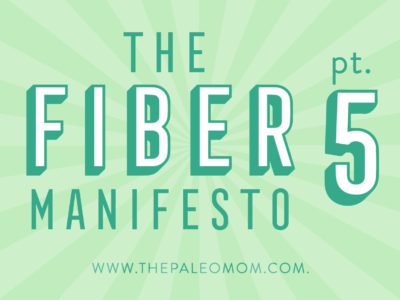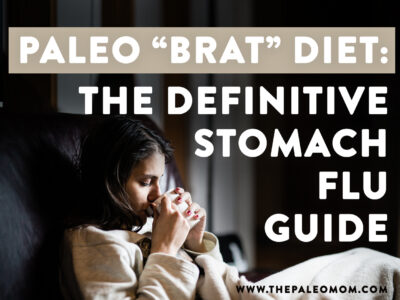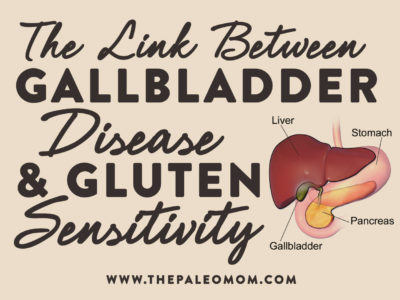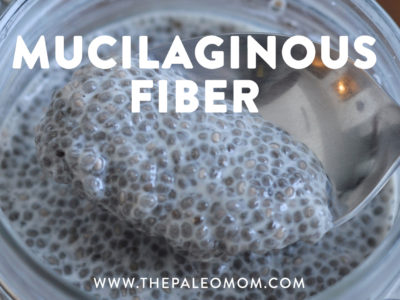Throughout the research for my first book, I kept hitting on a recurring theme. Dietary fiber is essential for good health. But I also kept hitting on pieces of information that went contrary to conventional wisdom (even contrary to conventional Paleo wisdom). Tidbits like insoluble fiber is even more beneficial than soluble (in spite of the fact that the vast majority of studies only evaluate the benefits of soluble fiber). Even more mind-blowing for me was learning that the whole insoluble fiber being abrasive thing is a myth. In fact, the deeper I delved into this subject, the more information I learned that completely challenged everything I thought I knew about this non-essential nutrient. And, the more everything started to make much more sense too.
I have been working on this series of posts for six months and am finally ready to share this information with you. I have broken this immense topic into five posts. The first post summarized some the correlative and prospective studies that have been done showing the benefits of diets rich in dietary fiber. The second post detailed the different types of fiber. The third post summarized the research showing that insoluble fiber has more health benefits than soluble fiber. The fourth post went into detail into how soluble fiber lowers cholesterol (and why that might not be a good thing). Now, the climax of this series and some more myth busting…
Part 5: Busting the Abrasive Insoluble Fiber Myth
It was very important to me that every recommendation I made in The Paleo Approach be backed up with modern science.
My starting point for the diet recommendations in The Paleo Approach was the Paleo autoimmune caveat as originally outlined in The Paleo Solution, plus the focus on vegetables suggested by Dr. Terry Wahls, and of course my own research for many blog posts explaining the why’s behind the Paleo Autoimmune Protocol that I had already tackled before I started writing the book (as I tried to optimize my own health). Through the last year of researching and writing, I made a point of reading through the scientific literature to make sure that every aspect of my recommendations could be backed up by science… and this led to some surprises for me. Some of the common recommendations made for those with autoimmune disease in the Paleo community could not be validated by science. An example is the traditional recommendation to avoid cruciferous veggies (because of their goitrogenic properties) for those with thyroid disorders, a myth which is busted in this post. And another of these topics is the avoidance of insoluble fiber for those with severe gastrointestinal symptoms and gut pathologies… turns out that this recommendation is not supported by science either.
As I researched the benefits of fiber, it became clear that a diet rich in vegetables and fruit (but not too high in fructose) was going to be essential for anyone to heal from an immune or autoimmune disease (or even to just be optimally healthy for that matter!). But, more than supporting the intake of fiber-rich foods in general, I kept finding studies supporting the benefits of insoluble fiber compared to soluble fiber (although there are clearly health benefits to soluble fiber as well, especially as prebiotic fibers). These benefits of insoluble versus soluble fiber have all been detailed in the previous 4 posts in this series (here, here, here and here).
But, insoluble fiber gets a bad rap. Both conventional medical doctors and alternative healthcare providers typically warn against consuming foods rich in insoluble fibers for those with a severely damaged gut (so common in autoimmune disease) because insoluble fiber is rough and abrasive. It has been likened to eating sandpaper, and supposedly causes damage to the gut as it scrapes its way through our digestive tract. Both conventional and alternative healthcare providers (including some leaders in the Paleo community) recommend avoiding insoluble fiber for people with IBD, IBS, diverticulitis and severely leaky guts.
So what is the evidence?
Diets rich in fiber reduce the risk of developing many gut pathologies. High fiber diets (especially insoluble) reduce the risk of diverticular disease (diverticulitis and diverticulosis). Very few perspective studies have been performed to investigate diet factors increasing risk of irritable bowel syndrome (IBS), but preliminary studies indicate that low fiber intake is a risk factor. High fiber and high fruit intake are both associated with decreased risk of Crohn’s diease. High vegetable intake is associated with decreased risk of developing ulcerative colitis.
However, decreasing the risk of developing the disease is different than what happens when you eat insoluble fiber-rich foods after the disease has developed. So, let’s look at that scenario.
If insoluble fiber were abrasive and irritating to the gastrointestinal tract, clinical trials where patients with diseases such as IBD, IBS and diverticulitis are supplemented with insoluble fiber should show exacerbation (or worsening) of their diseases. But, the handful of studies that have investigated the effects of insoluble fiber in these severe gut pathologies have not borne this out.
The impact of insoluble fiber on disease activity is best understood with diverticular disease. In diverticular disease, tiny pouches form in the colon due to weakening of the wall of muscles around the colon. These pouches are called diverticula, and the diagnosis when these pouches are discovered is diverticulosis. When these pouches become inflamed, diverticulitis is diagnosed. When inflammation is severe, diverticula can bleed. Traditionally, a diagnosis of diverticulitis or diverticulosis comes with a lifetime ban on insoluble fiber-rich foods like corn, popcorn, nuts, and seeds, and often low-residue diets (very low fiber) are recommended. However, the evidence supporting these diet recommendations has never actually existed. And in fact, the opposite has been proven: high dietary fiber intake not only prevents new diverticula from forming, but it also reduces the risk of complications (such as bleeding and diverticulitis) in patients with diagnosed diverticular disease.
One fascinating prospective study looked at whether dietary fiber increased or decreased the risk of complications in patients with diagnosed diverticular disease. This study showed that high intake of fiber from fruits and vegetables decreased risk of complications, but not cereal grain fiber (they were also able to show that it was the fiber in fruits and vegetables rather than other nutrients that made the difference). They further showed that high insoluble fiber intake, and especially cellulose (but also lignin and to a lesser degree hemicellulose)—but not soluble fiber—correlated with lowest risk of complications of diverticular disease. Even patients who suffered such severe diverticulitis that the diverticula were bleeding benefited from high insoluble fiber intake.
What about conditions affecting the small intestine rather than the large intestine, like Inflammatory Bowel Disease and Irritable Bowel Syndrome? In one large study, patients with Irritable Bowel Syndrome were blindly and randomly assigned either a soluble fiber supplement (psyllium), an insoluble fiber supplement (bran), or placebo. While soluble fiber significantly improved symptoms of IBS, insoluble fiber had only a marginal effect compared to placebo—but, it didn’t make things worse. A study using chitosan and vitamin C supplementation in Crohn’s disease patients showed no real benefit but also no detriment to disease activity.
This topic has been more thoroughly investigated in animal models than in humans (specifically animal models of ulcerative colitis). Hemicellulose supplementation has been shown to greatly improve disease activity in mice with colitis. Not only did hemicellulose supplementation reduce symptoms (like diarrhea), but it accelerated repair of the mucosal barrier and reduced inflammation, attributable at least impart to improvements in the gut microflora. Cellulose supplementation was also shown to improve colitis in mice. Again these benefits were attributable to changes in gut microflora; and very interestingly, when cellulose supplementation was stopped, the beneficial effects only lasted about 10 days before the disease started to worsen again.
There have been no studies performed on the role that insoluble fiber may have on healing the gut in celiac disease patients. Celiac disease is hallmarked by a shortening (called pruning) of the intestinal villi (the fingerlike columns of gut epithelial cells that increases the surface area of the gut to maximize nutrient absorption). A study evaluating the effects of two types of insoluble fiber (one rich in both cellulose and hemicellulose versus one rich in lignin) on the morphology of the small intestine in piglets (not celiac, but rather the developing intestine which is still likely very relevant) showed that insoluble fiber increases the height of the intestinal villi in both the jejunum and the ileum (and that’s a good thing).
It’s worth noting that within the relatively limited body of scientific literature evaluating the actual effect of insoluble fiber on the gut barrier, there is one situation in which insoluble fiber has been shown to be potentially damaging: NSAID-induced small intestinal ulcers. In one study, cats were fed diets that differed in fiber content (high, low, normal) and type (either cellulose or pectin) before being given very high doses of NSAIDs. The researchers found that the cats developed more ulcers if they received the high fiber diet compared to control and fewer ulcers if they received a very low fiber diet. They also found that cats that received cellulose-enriched diets developed more ulcers, but not pectin. The authors conclude that insoluble fiber contributes to the development of NSAID-induced ulcers. So, I guess if you are taking large doses of NSAIDs (and especially if you are a carnivore), this may be an argument for a low fiber diet.
The take-home message: there is no evidence that insoluble fiber is abrasive to the gastrointestinal tract and there is no scientific rationale for avoiding insoluble fiber for those with gut pathologies including irritable bowel syndrome, inflammatory bowel disease, and diverticular disease. In fact, eating plenty of fruits and vegetables will likely speed your healing.
Okay, so what do you do if you have a condition like IBS or IBD and eating foods rich in insoluble fiber, like leafy greens, causes you increased gastrointestinal symptoms? What does it mean if you can see intact food particles in your stool after eating these high insoluble fiber foods? This is a reality for many people and one that helps to perpetuate the myth that insoluble fiber should be avoided. But, this isn’t a case of insoluble fiber being the problem so much as it being a symptom—it’s the big red flag indicating the need for digestive support.
The first step in improving digestion is always to follow good meal hygiene: don’t rush, chew thoroughly, enjoy your meal, relax, don’t stress, don’t rush to the next activity when you’re done, don’t drink tons of liquid with your meals. Also avoid alcohol, caffeine, smoking, and high stress, which can all hinder digestion (by lowering stomach acid production, which then reduces the signals to the pancreas to release digestive enzymes and the gallbladder to release bile into the small intestine). Next, consider digestive support supplements, especially plant enzymes which can be particularly beneficial in aiding digestion of fiber-rich foods (I recommend either Enriching Gifts or Thorne Research). Pancreatic enzymes (also called pancreatin, or simply, digestive enzymes), ox bile, and betaine HCl may also be very beneficial (careful with HCl supplements since these are contraindicated in a variety of conditions so always check with a healthcare professional before taking them) or an all-in-one supplement. It is generally recommended for patients with gastrointestinal diseases to increase dietary fiber slowly. That seems like prudent advice to me. You may also want to limit yourself to cooked or fermented vegetables as these are both easier to digest. Also, low FODMAP diets have been well documented to be beneficial in treating IBS and SIBO. But don’t cut out insoluble fiber-rich foods altogether—there’ no evidence that avoiding insoluble fiber-rich foods will help you (it might even slow your recovery!) and you’d be missing out on some of the most beneficial foods you can eat for your long term health.
Aldoori WH, et al, A prospective study of dietary fiber types and symptomatic diverticular disease in men. J Nutr. 1998 Apr;128(4):714-9.
Ananthakrishnan AN, et al, A Prospective Study of Long-term Intake of Dietary Fiber and Risk of Crohn’s Disease and Ulcerative Colitis. Gastroenterology. 2013 Nov;145(5):970-7.
Bijkerk CJ, et al, Soluble or insoluble fibre in irritable bowel syndrome in primary care? Randomised placebo controlled trial. BMJ. 2009 Aug 27;339:b3154.
Hou JK, et al, Dietary intake and risk of developing inflammatory bowel disease: a systematic review of the literature. Am J Gastroenterol. 2011 Apr;106(4):563-73.
Kanauchi O, et al, Germinated barley foodstuff, a prebiotic product, ameliorates inflammation of colitis through modulation of the enteric environment. J Gastroenterol. 2003;38(2):134-41.
Kanauchi O, et al, Dietary fiber fraction of germinated barley foodstuff attenuated mucosal damage and diarrhea, and accelerated the repair of the colonic mucosa in an experimental colitis. J Gastroenterol Hepatol. 2001 Feb;16(2):160-8.
Kanauchi O, et al. Germinated barley foodstuff ameliorates inflammation in mice with colitis through modulation of mucosal immune system. Scand J Gastroenterol. 2008;43(11):1346-52.
Malhotra S, et al, Dietary fiber assessment of patients with irritable bowel syndrome from Northern India. Indian J Gastroenterol. 2004 Nov-Dec;23(6):217-8.
Nagy-Szakal D, et al, Cellulose supplementation early in life ameliorates colitis in adult mice. PLoS One. 2013;8(2):e56685.
Satoh H, et al, Role of dietary fibres, intestinal hypermotility and leukotrienes in the pathogenesis of NSAID-induced small intestinal ulcers in cats. Gut. 2009 Dec;58(12):1590-6.
Schedle K, et al, Effect of insoluble fibre on intestinal morphology and mRNA expression pattern of inflammatory, cell cycle and growth marker genes in a piglet model. Arch Anim Nutr. 2008 Dec;62(6):427-38.
Strate LL, et al, Nut, corn, and popcorn consumption and the incidence of diverticular disease. JAMA. 2008 Aug 27;300(8):907-14.
Tarleton S and DiBaise JK. Low-residue diet in diverticular disease: putting an end to a myth. Nutr Clin Pract. 2011 Apr;26(2):137-42.
Tsujikawa T, et al, Supplement of a chitosan and ascorbic acid mixture for Crohn’s disease: a pilot study. Nutrition. 2003 Feb;19(2):137-9.












